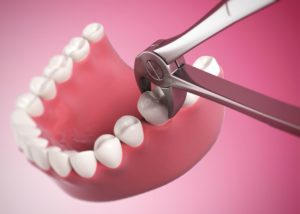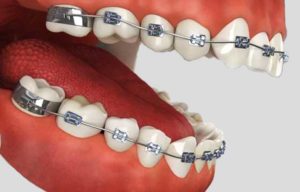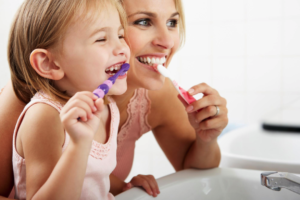Myth associated with Baby teeth

One of the most common myths associated with dental care is that “There is no need to treat the milk teeth as they are going to fall off”. This however is far from true. Let’s get to the basics of the need for preserving the baby tooth and its role in growth and development.
What are functions (uses) of milk teeth?
1. The milk teeth does all the functions of permanent teeth, in addition to that, the milk teeth act as natural space maintainers, that is they help to maintain the space for the future permanent teeth to erupt. If by any chance a baby tooth has to be removed then that space has to be maintained using special appliances (Space maintainers). Otherwise that space will reduce and the permanent tooth which is supposed to erupt in that space will get locked in the bone or may erupt in a wrong position.
2. The presence of all the milk teeth is also very essential for the proper growth of the upper and lower jaws, which in turn affects the patient’s facial profile and appearance.
3. Deep cavities in milk teeth can induce a lot of pain, which in turn affects the food intake of the child, thereby even leading to malnutrition, if left untreated.
4. An infection from a baby tooth if left untreated can affect the proper development of the permanent tooth that follows it, sometimes leading to a disorder of the enamel called as “Turner’s hypoplasia”
5. Badly mutilated or broken down teeth (especially the front teeth) does induce some inferiority complex in the child due to peer pressure. We often have parents complaining that such children refusing to attend school properly.
Hence it is very important that every parent understands the importance of milk teeth and take all efforts to maintain them in proper form and shape and initiate all necessary treatment at the earliest if required.
We strongly suggest that the first dental visit for a child should start as soon as the first milk tooth erupts and the habit of yearly dental check-up should be practised to detect problems when they are in the early stages.
Post Extraction Instructions
Extraction of a tooth is best avoided in most instances and only carried out as a last resort if the tooth is badly affected and beyond repair. However for whatever reason if a tooth has to be extracted, here are the simple tips for a trouble free experience post extraction.

• Bleeding from the site of tooth removal is not uncommon and can be arrested (stopped) by biting hard on a piece of cotton or gauze usually for a period of 45 minutes.
• If there is slight bleeding after removal of the cotton pack, one need not panic, but have to just bite on another tight pack of cotton for another 30 minutes.
• If the extraction happens to be surgical procedure (usually happens with wisdom tooth), then a cold / ice pack has to be placed externally, just at the side where the procedure was done, for about two hours. Ice application helps reduce swelling and pain associated with any surgical procedure. The earlier the ice application is started, the better it is.
• On the night of tooth extraction it is better to sleep with head a little raised (may be one can use an additional pillow)
• It is advisable not to touch the face or apply any kind of external pressure.
• Strictly no external balm application should be done. This can cause extensive pain, swelling and can delay healing.
• For the first 24 hours following tooth removal one should consume (eat or drink) only cold stuff. Hot and spicy food and liquids have to be strictly avoided.
• For 24 – 48 hours following tooth removal, one should take only liquid or soft food stuff, and should avoid chewing on the side where the tooth was removed.
• While brushing that day and the next day, it is better to avoid the site of tooth removal.
• Strictly avoid fiddling the extraction site with your finger or tongue.
• Smoking has to be strictly avoided for a minimum of 72 hours following a tooth extraction
• If stitches have been placed, then one should visit the dentist to get it removed after 8 – 10 days.
If you still have any queries in your mind regarding the post extraction care, feel free to contact our office. One of our doctors would be glad to help you out.
Dos and Don’ts when you are wearing braces
Dental braces which are used to correct  of teeth, involves application of force or pressure, to move teeth to the desired location, thereby improving smile and self-confidence of an individual. Here are some simple Dos and Don’ts to be followed to ensure you have a pleasant and trouble free experience with the braces.
of teeth, involves application of force or pressure, to move teeth to the desired location, thereby improving smile and self-confidence of an individual. Here are some simple Dos and Don’ts to be followed to ensure you have a pleasant and trouble free experience with the braces.
• Use a specialised brush called orthodontic brush and brush twice a day. Make sure to brush gently without applying lot of force, and making sure to reach all the areas of teeth. Make sure to change your brush once in 3 months.
• Also consider using a Proxa brush (inter dental brush), small cleaning device to clean the not so easy to reach areas like in between the wire and the teeth, around the braces etc.
• Use a fluoridated mouthwash and gargle twice a day, especially before bed. Also rinse with plain water after you eat or drink anything.
• Maintenance of good oral hygiene is an absolute prerequisite for successful orthodontic correction.
• Never use your front teeth for chewing food. Always chew on your back teeth.
• Drop the habit of biting a full apple or a guava or anything for that matter using your front teeth. Cut them into pieces and eat with your back teeth
• Please avoid drinking colas or any carbonated drinks. You can have a lot of fruit juices rather.
• Avoid food stuff that sticks to your teeth like candies, potato chips and chewing gums. These can potentially debond (remove) the brackets from the teeth, causing potential injury and even delay in treatment.
• As much as possible stick to the schedule given by your orthodontist and do not skip any visits.
• If you find any loosening of wire or any part of the braces, or any trauma to your mucosa (soft covering of the inside of your mouth), please report to your dentist immediately.
Best oral hygiene practices for kids

1.Teach them to brush
The best way children learn a habit is by observing their parents or family members. Hence the best way to teach them proper brushing is to brush in front of them, commonly described as the “tell, show do technique”. These few minutes parents spend in the morning and at night goes a long way in shaping the brushing habits of their kids.
2.Develop proper food habits
It is extremely mandatory to develop proper eating habits for kids right from their early childhood. Kindly avoid too much of sugary stuff, anything that contains refined sugars and processed food. This would reduce the availability of sugar in the mouth, which the bacteria uses to produce acids, thus causing cavities.
3.Regular dental visits
Dental consultation for a child should start early, and ideally before the occurrence of any problems or symptoms. Regular visits would ensure that any dental disease can be detected early and the child does not suffer from pain, which can affect their food intake and overall health.
4.Be their role model
It is very essential that the parents do and follow all that they preach to their children, only then would children understand the importance of what we tell them. Parents should themselves adhere to good eating habits, proper brushing and pay regular visit to the dentists, so that children would emulate them without any hassles….









